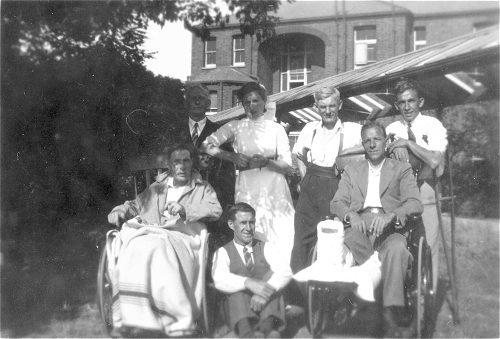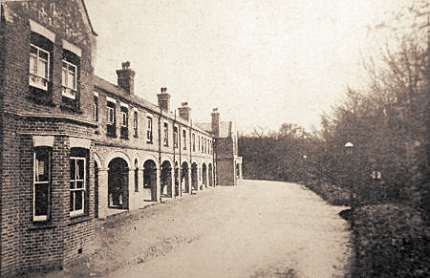
Joyce Green Hospital
Dartford's close proximity to London provided the Metropolitan Asylums Board (MAB) an excellent out of London location for the construction of several large isolation hospitals such as the Joyce Green Hospital, Gore Farm (The Southern Hospital) and the temporary Orchard and long reach Hospitals, these establishments were intended for the isolation of London's fever and smallpox patients, the Metropolitan Asylums Board (MAB) also financed the construction of several mental institutions within Dartford's boundary's the most impressive being Stone House Hospital which closed in 2007 and is awaiting conversion to flats.
Infectious diseases such as smallpox forced Londoners to initially use ships moored in the Thames as floating isolation hospitals, the ships "Atlas," "Castalia" and the "Endymion" were superseded in 1903 by the completion of Joyce Green Hospital; its opening was the last of the River Hospitals which also included the Orchard and Long Reach Hospital, the three isolation hospitals stood on an estate of 340 acres situated by the River Thames approximately 1 1/2 miles from Dartford town centre.
The Hospitals were all designed by the Metropolitan Asylums Boards preferred architect A & C Harston, Joyce Green Hospital itself covered 98 acres and had accommodation for 940 patients. The hospital had twenty two wards arranged in a symmetrical pattern which can be seen on this on site 1970's visitor map.
Joyce Green was closed in September 2000 and services transferred to The Darent Valley Hospital today the site is part of the Bridge housing development and all what remains of Joyce Green today are the trees that received tree preservation orders. Please click here for a collection of Joyce Green Hospital Photographs.

Staff and patients at Joyce Green Hospital during the war
The outbreak of the 2nd world war in 1939 saw Joyce Green change from a fever hospital to an Emergency Medical Hospital its bed allocation was increased from 986 to more than 1500 specialist units such as x ray were set up to deal with the casualties of war. With the cessation of hostility's in 1945 patient numbers fell to 428. Unlike the nearby King Edward Hospital Joyce Green survived the war with little bomb damage. Above staff and patients at Joyce Green Hospital during the war

Nurses at Joyce Green Hospital
Above Staff Nurse Marriman, Mc.Kenna and Cowell taken behind ward I in June 1941. The Image below shows more Joyce Green Hospital Dartford staff during the war.

War time Nurses at Joyce Green Hospital

Orchard Hospital
The Orchard Hospital was classed as a 'temporary' hospital its timber-structured buildings were quickly erected within an 63 acre site in 1902. The hospital provided some 800 beds that were to be used encase of an widespread epidemic. In 1916 the Australian Military acquired the Orchard Hospital for the treatment of its First world war wounded, during its Australian occupation the Orchard was known as..The Dartford Australian Auxiliary Hospital following the cessation hostility's the Australians departed and the hospital was little used. On September 3 1939 the Orchard Hospitals fate was sealed when the UK's Prime Mister of the time Neville Chamberlain announced Britainís involvement in the 2nd world war. German air raids were soon to follow and the Orchard hospital was badly fire bombed. After the war some of the remaining buildings was converted to agricultural use and the remainder demolished. Today as with Joyce Green Hospital the Orchard site is now part of the Bridge housing development.
The Long Reach Hospital opened on the 27th, February,1902. The wards were built of wood and could accommodate 300-350 patients within a 24 acre site, like the nearby Orchard facility it was classified as 'temporary' its purpose only to alleviate over crowding of the hospital ships and to provide beds until the permanent Joyce Green hospital was completed. Despite originally been classified 'temporary' Long Reach received an upgrade in 1928 when permanent wards replaced the wooden huts.
The hospital was flooded in 1957 but remained on smallpox standby until its last patient in 1973. the buildings remained empty for a few years before Long Reach Hospital was demolished to make way for flood defences.
The three River Hospital were connected by a horse drawn tram system, patients who were transported from London via the ambulance steamers (Albert Victor & Geneva Cross) arrived first at Long Reach Pier and then conveyed to the wards by a horse drawn tram. From Long Reach Pier the furthest point possible of travel via the tram system would have been Joyce Green Hospitals South Gate, in all a total of 3.4 miles of track was laid. The tramway track remained until 1943 when it was removed and used as scrape metal to help with the war effort.

Gore Farm Hospital
Gore Farm Hospital was also constructed in 1888-9 by the Metropolitan Asylums Board it resided in Darenth Woods Dartford over the years sections of the establishment were renamed The Southern Hospital Upper and Lower, The Dartford War Hospital, US Base No 37, and finally the Mabledon which closed in 1985. Please click here for a collection of Gore Farm Photographs